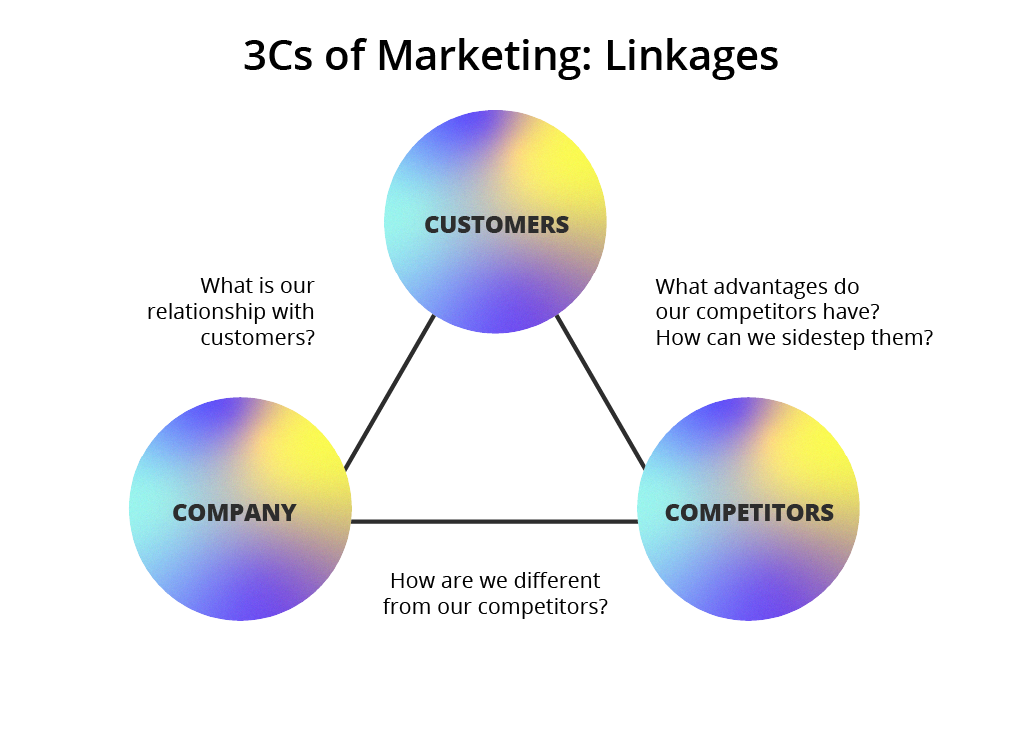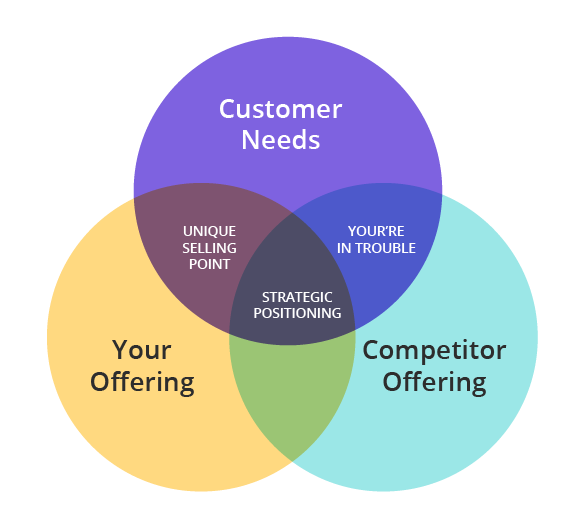Positioning Strategy: Guiding Perfect Value Propositions
When a new company first appears on the market or launches a new product or service, there is plenty to get done — and to communicate. Read on to learn the benefits of a strong positioning strategy.
In addition to investing to discover how their product/service can deliver value, organizations need to clearly define their positioning strategy, as well as the value proposition of each solution.
Luckily there are marketing tools that can lend a hand in this fight when communicating a brand’s position in the market. And when it comes to doing the above, we should call upon the services of a solid positioning strategy to market a brand to a desired segment of customers.
A solid positioning strategy can translate into elements such as a premium price, lower costs or company culture & values. It must reflect a company’s choice about the kind of value it will add and how it will be unique.
Read on to learn and see:
• What a strategic positioning is
• The benefits it offers
• And how it facilitates the communication of your value propositions
Bonus: Keep an eye out at the end of this article for a few tips on how to write an attractive value proposition
What is a Positioning Strategy?
A positioning strategy is a strategic marketing plan that helps determine where your business stands in the market and how it should be positioned to attract more customers. It is a marketing strategy focused on distinguishing a brand from its competitors.
A positioning strategy aims to establish the defining characteristic of a brand in the consumer’s mind to influence customer perception to communicate a brand’s competitive advantage effectively.
It’s all about showing the audience how a brand wants to be perceived in the mind of customers relative to competing brands.
What it brings to the table? The benefits of Strategic Positioning
Effective positioning strategies consider the strengths and weaknesses of the organization, the needs of the customer, and the claims of competitors.
Effecting Growth: Effective strategic positioning ensures that an organization’s marketing tactics have an impact on customers instigating them to take action.
Without communicating a product/service’s best qualities to a customer segment, an organization can’t grow.
Product positioning allows a company or brand to illuminate areas where it can eclipse the competition, but this can work both ways:
A poorly positioned product will never reach its full potential, no matter how well it is marketed. In contrast, an excellent positioning strategy can be all that stands between failure and profitability.
Positioning strategies help companies become an authority in their field, distinguish themselves from competitors for better brand recognition, or even create new markets by identifying unmet needs among consumers. More specifically, businesses may use this approach when going up against established players who have been around longer.
A good brand positioning creates a unique space for the product or service in the customer’s mind. It can do this in various ways, one of which can subtly attack the competition. Another can be making the product unattractive to the right audience or targeting the wrong audience.
How about an example to drive you in the right direction.
Learn everything you need to create a unique, powerful positioning. Click on the button to download the free Value Proposition Rodamap now >>>>>>>>>>>>
Uber vs. Lifts: same service, different position
Lyft & Uber are ride applications that offer similar services yet have radically different brand positioning.
Uber pioneered their market – with their jet black branding and sleek logo. Their vision was clear from the start: exclusive and luxurious. Whereas Lyft cars were bright pink, and drivers were billed as being “fun and interesting.”
Essentially, Lyft understood they had to be different, and although they followed much of what Uber had pioneered. They took their branding and culture in the opposite direction. You see, positioning influences pricing, marketing, and sales strategy. But to be truly successful, the strategy needs to make sense to different target groups of customers.
What if a company copy your solution? Well, then you’re the reference.
TIP. Focus on being unique, not better: Unsuccessful positioning strategies focus on proving a company is better than the competition rather than different.

An organization needs to tell a story about its unique brand and find the most effective ways to share that information with others. And when you have the story figured out, It’s essential to maintain consistency and not deviate from the original story, as that is what initially gained customer loyalty in the first place.
The Pillars of Positioning Strategy
Successful branding hinges on a company’s understanding of the market and its target audience. And in our view, three key components make up an effective positioning strategy:

1. Channel: Your channel is how customers interact with your brand. Use market research to collect consumer desires and behavior metrics, then leverage this information to best connect with your customer.
Your channel is also central to understanding customer needs and is where you will likely find the majority of information for successful positioning. It is a direct connection to the consumer; you can get information such as the customer profile, customer problems, competitive intelligence, and the purchase process.
Channels help identify brand strengths to effectively focus your positioning strategy on what you do well as a brand.
2. Customer: Knowing your focus is crucial for positioning. This is done by identifying what the buyer wants and needs. Knowing your target demographic will help guide decision-making when developing marketing plans. This understanding is essential for ensuring that you’re using the correct pricing strategy to maximize profitability.
Research to see if there is a problem customers need a solution for and what needs they might report via surveys, interviews, and reviews. Listening to buyer needs and placing a high importance on those needs is pivotal in getting customer attention and loyalty.
3. Competition: A final step in formulating a product position is paying attention to your competition and its position. Evaluate your market position relative to your direct competitors. If yours is unique and easily differentiated from what is on the market, then your positioning statement is effective.
TIP: A positioning map can help visualize where your company stands in customers’ minds and can be a key tool for informing your overall business strategy.
Beat out the Competition: How to Consolidate a Positioning Strategy
Competing against other brands is an integral part of positioning strategy, which means understanding what makes your product better than theirs and positioning it accordingly.
The best way to ensure a position that sets you apart from the competition is by ensuring your products stand out from what’s already on the market.
TIP: make sure not one aspect of your offering can be replicated easily or made cheaper.
The key again is doubling down on strengths. But how does all this integrate into helping form the best possible Value proposition? To answer that, let’s refresh our memories on:
What is a Value Proposition? (quick recap)
Value propositions describe the functional and emotional benefits of companies and their brands. Functional benefits are linked to specific product features, while emotional benefits refer to positive feelings that customers experience when using a company’s products and services.
A value proposition should tell customers why they choose your product or service; it communicates what lies in store for them. Value propositions should speak to customers’ pains and place your company as the remedy.
A good value proposition highlights what sets you apart. Without a strong value proposition in place, customers will not understand what you can offer them, leading to a lower conversion rate.
Value propositions are not necessarily about offering the cheapest products; they are about convincing customers that they are getting value for their money.
Positioning Strategy at the core of Value Proposition
Value propositions and positioning strategies are both designed to differentiate companies from their competitors. A company’s value proposition describes the benefits of its products and services.
Value propositions flow from the positioning strategy as the two should always reflect each other. A basic value proposition strategy only focuses on a product’s features and benefits.
To build a competitive customer value proposition,
you need to win over the market.
Brands need to go deeper with their value propositions, explaining the problem the product or service solves and how it can create positive gains and improvements in its customers’ lives. Many businesses fail early on because they haven’t thought through their brand proposition strategy to clarify what makes them unique.

How To Write an Attractive Value Proposition
So enough of the setup, it’s time for action. What are the keys to creating a value proposition that stands out from the crowd? Here at MJV, we believe there are a few major factors that a crucial to making your value proposition shine through:
• The language: You have to use the same language as your audience; basically, the magic here is to use the language of your current customers to attract your future ones. Use surveys to reach out to your existing customers and ask them how they describe your products and company.
• Clarity: We all like a bit of flair from time to time, but with a value proposition, first and foremost, the goal needs to be clear over creative. Your VP needs to be crystal clear and easy to understand. No more than three or four sentences, right?
TIP: When writing drafts, ask yourself whether or not the value proposition answers the following questions:
– What do you sell?
– Why should people buy your product or service?
– How does your product or service make your customers’ lives better?
– Why should someone buy from you over your competitors?
• Benefits: IT’S MONEY TIME; this is what it is all about, your moment to comment on your offerings, but, unless you are already a market leader, nobody is going to really care about your product’s features; what will pique their interest, though, is its benefits.
TIP: Focus on benefits, not features. Highlight the distinct value your product promises to deliver. What are you offering, and what makes it special? This is your chance to wax lyrical and make a difference.
• The Aesthetics: Now just cause you need to be clear in conveying your message, that doesn’t mean you shouldn’t make it look great. Use visual elements to make your message come across attractively.
TIP: In some cases, a video, infographic, or image may convey your value proposition better than words alone can. Enhance your message with these visual elements to capture your audience’s attention.
Example: Apple
It’s a classic example, but a good one. I’m sure we are not breaking any ground by sharing this with you, but Apple knew how to set its iPhone apart from the many competing devices on the market.
In their value proposition, you got what you’d expect from Apple; they communicated their commitment to sleek, elegant product design. And specifically about the device’s design, they highlighted its ease of use and the aspirational qualities that an iPhone supposedly offers the user.
Apple’s value proposition states that it believes a phone “should be more than a collection of features” – despite the fact that this is precisely what a smartphone is.
Apple’s remarkably effective approach has helped them remain at the top for more than a decade in an incredibly competitive market.
When to Write a Value Proposition?
As Soon As Possible! Once you understand who you are and your public, your value proposition needs to be out there for the world to see.
A value proposition can enable a brand to sharpen and improve how customers perceive them increasing the likelihood of gaining market traction. But developing this requires an understanding of your customer’s issues and needs.
To best understand these factors, a sound positioning strategy can be a big game changer. If your company does not already have one in place, you should start now and begin understanding how to build the best possible positioning strategy. Need help? Contact us!
Final Tip: Helps find the right staff: Clear proposition strategies and value propositions help persuade new staff to join your team. When you clearly state what is expected from potential new team members and what your company stands for, you ensure new colleagues already understand your fundamental values.
At the end of the day, companies need to be doing everything within their grasp to convey the best possible value proposition, as ultimately, it shows how the brand will deliver on the customer’s needs better, cheaper, and faster than the competition does.
For a more comprehensive vision of value propositions, check out our Value Proposition Roadmap.
Back

